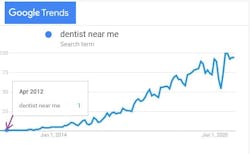Reach more prospective patients in 2021 by understanding current search trends
Not long ago I had a discussion with a dentist who felt that his website wasn’t working. He said that when you searched on Google for “[his city] dentist,” his practice didn’t appear until page four. However, when I looked at his website metrics, I could see that the site had excellent traffic. It was averaging over 6,000 unique visitors per month, with almost all of that traffic coming from search engines. If you can relate to this dentist’s confusion, this article is for you. I’ll review what’s going on in the world of search in 2021 so you’re better equipped to evaluate whether your website company is doing a good job.
In the case of the dentist mentioned previously, the answer lies in that most people aren’t searching for a dentist the way he was—sitting down at a desktop computer, typing in “[city] dentist,” and then picking one from the results on the first page of Google. Ten years ago people were doing that, but they aren’t today. Three-quarters of searchers are using their phones, and many of them have changed the search terms they’re using.
Let’s start by looking at some research we did for this dentist. We were able to survey 12 new patients just after they requested appointments (when the information would be fresh in their minds), and here’s how they responded to being asked how they found his website. (In the interest of privacy, I’m not disclosing location information. Unless stated otherwise, all searches were on Google.)
• Facebook
• searching for “dentist near [my city]”
• searching for “cosmetic dentistry [my city]”
• searching for “dentist”
• searching for “dentist near me”
• searching for “conservative dentistry”
• recommendation from a friend
• searching for “lumineer”
• searching for “invisalign”
• searching on Apple Maps• searching for “dentist on [street name] [my city]”
So, in spite of his website showing up on page four of a Google search for “[his city] dentist,” 10 out of 12 new patients found him with an internet search, nine who used Google and one who used Apple Maps. In fairness, we should add that for the new patient who specified the street name, there is a real possibility that they saw the dental office while driving by and then looked it up. But that’s still 75% of our sample using search to find a practice website that the owner thought was performing poorly.
Changes as a result of Google Local
Google launched Google Local in 2004: “Google Inc. today announced the integration of local search results into Google.com with the availability of Google Local. This new feature enables users to find relevant local information with neighborhood business listings, maps, directions, and useful web pages.”1
Today, Google Local has grown to replace printed yellow pages directories, and other search engines have developed similar features. As these services grew, they changed both search behavior and search results. About 10 years ago, we could help a client who wanted to show up in search results for a particular geographic location by creating a page optimized for that location. That strategy no longer works. Now Google pulls location information from your business listing, matches that to your website, and displays your business as a search result for that area. At the same time, searchers have come to understand that Google detects their locations, and they don’t need to type location information into their search.
Today, when a searcher keys in “dentist” without a city, they are assuming that Google knows where they are and will deliver results near them. Those results will vary depending on where in the city they are located. Also, how they phrase their searches will affect the results. Try these searches yourself, and you’ll see that you get different results for each different wording: “[your city] dentist,” “dentist,” “dentist near me,” and “dentist near [your city].” To further complicate things, you’ll receive different results depending on whether you’re using a desktop computer or your telephone.
To illustrate this change in mindset, let’s look at the tremendous growth in the popularity of searches for “dentist near me.” The first time people used this phrase in any measurable degree was in April 2012. Now it is common. Figure 1 shows a graph created from Google Trends data2 showing the dramatic growth in the use of this phrase. The numbers on the left side of the chart represent the percentage of the peak use of the search term, which was hit during the last year.
It’s time to divorce yourself from the idea that everything hinges on your ranking for “[your city] dentist.” That’s not the way people are searching anymore. Instead, judge the success of your website by looking at your website traffic metrics and asking new patients how they found you.
Dealing with changes in Google’s algorithm
I wrote an article a year ago about how Google has been downgrading some health-related websites for reasons that still aren’t clear. Some websites that are following all the rules, that have excellent information, and that rank well with other search engines simply aren’t doing well on Google. In 2018, Google released what came to be known as its “medic” update. Analysts came to understand that Google had decided to depart from its earlier democratic strategy of rewarding websites based on “votes” from other websites in the form of links. Instead, in an effort to achieve certain social goals, they adopted an authoritarian strategy, setting themselves up as the arbiters of correct information. Some quality websites became collateral damage in this time of tinkering with search results.3 The good news is that your ranking in what we call “general search” for the search term “[your city] dentist” isn’t that critical, as I pointed out above.
Adjusting to 2021 search behavior
There are two main adjustments that must be made to your search engine optimization strategy.
The first is to take advantage of the growing tendency for people to use more involved search terms. Because of Google’s growing sophistication, they are expecting Google to be able to answer their questions and help them with their decisions.4 In anticipation of this behavior, your website should be using a variety of search terms. Notice that in the example mentioned above, some patients were searching for a specific procedure or product, such as Invisalign or Lumineers. Another patient expected Google to be able to help them find a dentist with a conservative treatment philosophy. To reach all of these people, your website should have custom-written content addressing all significant procedures that you perform, and the content should include rich information about you, your style of practice, your treatment philosophy, and anything else that might be of interest to prospective patients.
At my company we conduct ongoing research on the search terms patients are using when they are interested in making an appointment. Here is a list of some of the creative search terms that have been used by patients of our clients in the past month:5
- inflamed gums
- best dentist Humana providers
- TMJ specialists
- lupus dentist near me
- resin bonding
- anxiety dentist
- Bioclear near me
- how to fix big front teeth
- gum recession
- is bleaching your teeth at home safe
- TMJ pain
- top-rated dental offices
- fixed bridge near me
The other adjustment to consider is to take advantage of what is called “local search.” Local search uses a different algorithm from general search because it serves a different purpose. Rather than being a means for seeking information, Google has designed it to help you find local businesses. It’s the replacement for the yellow pages. It is effectively free of Google’s social engineering mindset. The strength of a website in general search is only one of several key factors in the rankings. Results are delivered on a map and are also displayed in three listings accompanying a map at the top of any search Google interprets as having local intent. Several dental website companies today are offering quality local search services.
The bottom line
We find a lot of dentists obsessed with their website ranking using out-of-date search behavior. Hopefully the information presented here will help you make wise decisions about your internet marketing strategy.
References
1. Google connects searchers with local information. Google News. March 17, 2004. Accessed October 19, 2020. http://googlepress.blogspot.com/2004/03/google-connects-searchers-with-local.html
2. Graph indicating interest over time for search term “dentist near me.” Google Trends. Accessed October 13, 2020. https://trends.google.com/trends/explore?date=all&geo=US&q=dentist%20near%20me
3. Hall DA. Was your website hit by Google’s “medic” update? Dental Economics. December 1, 2019. https://www.dentaleconomics.com/practice/marketing/article/14072764/was-your-website-hit-by-googles-medic-update
4. House S. 3 search behavior trends to know in 2019. Insights Association. January 11, 2019. Accessed October 19, 2020. https://www.insightsassociation.org/article/3-search-behavior-trends-know-2019
5. Hall DA. Search trends in 2020. Infinity Insights. September 21, 2020. Accessed October 14, 2020. https://www.infinitydentalweb.com/blog/search-trends-2020/
DAVID A. HALL, DDS, AAACD, graduated with honors from the University of Minnesota School of Dentistry and ran a private practice in Cedar Rapids, Iowa, for many years. In 1995, he launched a website promoting his own dental practice. After requests from other dentists for help with their websites, in 2009 he founded Infinity Dental Web, a marketing agency that does digital marketing for dentists. Contact Hall at (480) 273-8888.
About the Author

David A. Hall, DDS, AAACD
DAVID A. HALL, DDS, AAACD, graduated with honors from the University of Minnesota School of Dentistry and ran a private practice in Cedar Rapids, Iowa, for many years. In 1995, he launched a website promoting his own dental practice. After requests from other dentists for help with their websites, he founded Infinity Dental Web in 2009, a marketing agency that does digital marketing for dentists. Dr. Hall may be contacted at (480) 273-8888.

